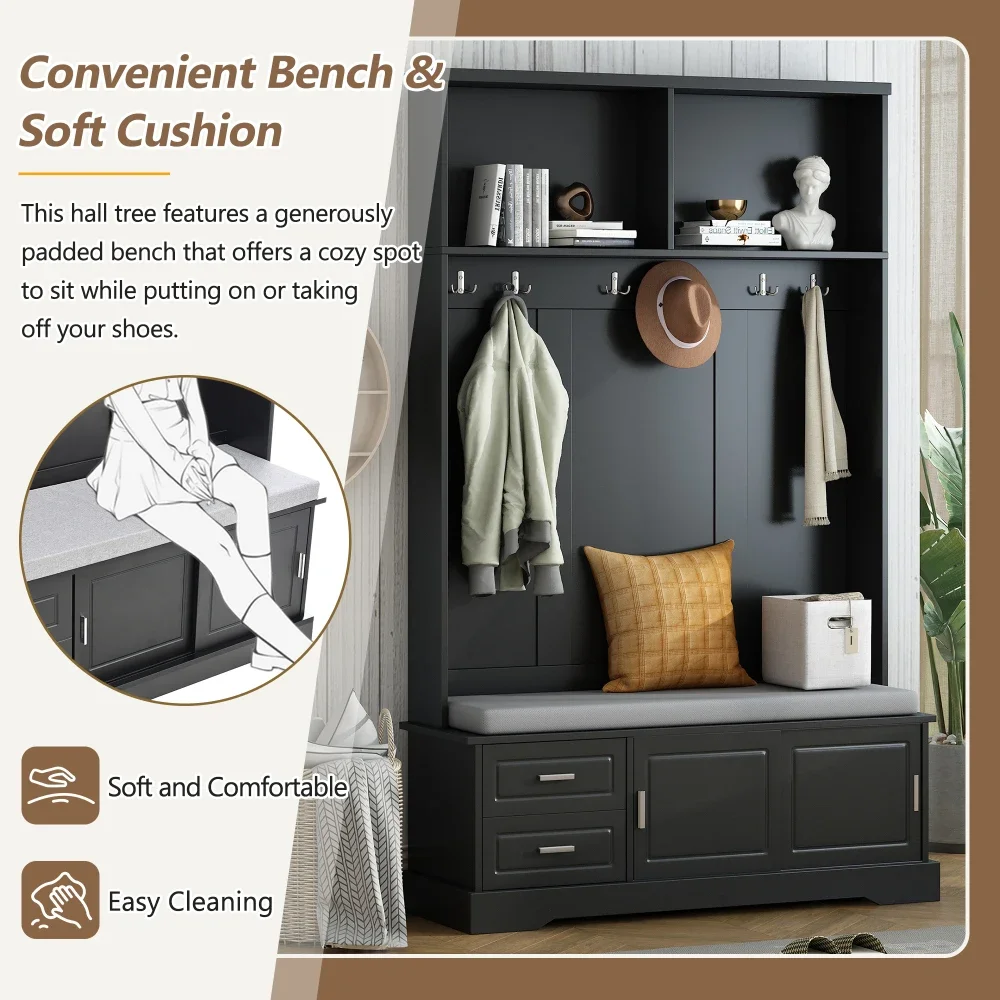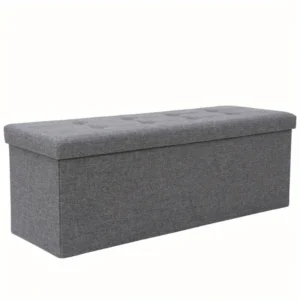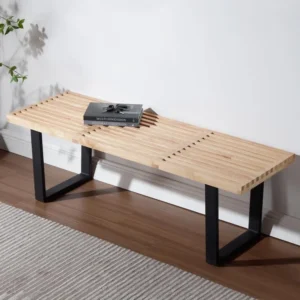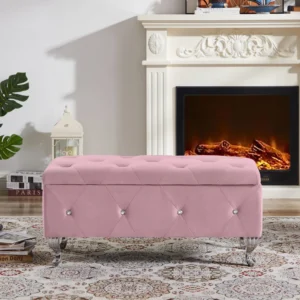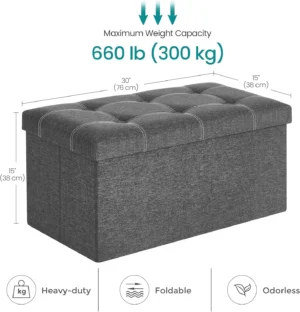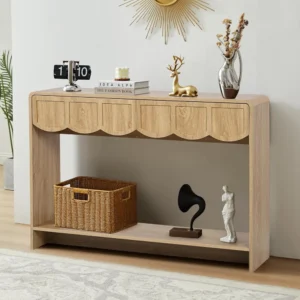The Timeless Charm of Wooden Benches in Home Decor
Wooden benches have adorned homes for centuries, evolving from simple seating solutions to versatile design elements that enhance any space. These timeless pieces bring warmth, character, and functionality to modern interiors while connecting us to traditions of craftsmanship that span generations.
The appeal of incorporating wooden benches into your home goes beyond their practical use:
- Natural warmth and texture that softens modern spaces
- Versatility across different rooms and functions
- Space efficiency compared to bulkier furniture options
- Sustainable material choice that ages beautifully
What makes wooden benches truly special is their ability to transform spaces without overwhelming them. Whether placed in entryways, living rooms, or bedrooms, they create an immediate focal point while serving practical needs. This perfect balance of form and function embodies what we at Nested Goods call “Where Function Meets Style.”
The evolution of rustic farmhouse bench designs shows how these versatile pieces have remained relevant through changing design trends. From medieval dining halls to contemporary minimalist apartments, wooden benches have proven their enduring appeal by adapting while maintaining their essential character.
Today’s wood entryway bench options demonstrate this versatility, offering solutions that work in spaces both large and small, traditional and modern. Their adaptable nature makes them perfect for homes where every piece of furniture needs to earn its place through both beauty and usefulness.
Selecting the Perfect Wooden Bench for Your Space
Choosing the right wooden bench begins with understanding what role it will play in your home. Will it primarily provide seating, create storage solutions, display decorative items, or serve as an accent piece? This foundational question guides all other considerations.
Once you’ve determined its purpose, measuring your space becomes critical. Consider these dimensions:
- Width: Ensure the bench fits proportionally within your space (typically 36-60 inches for entryways)
- Height: Standard seating height ranges from 17-19 inches for comfort
- Depth: Allow 15-18 inches for comfortable seating without protruding too far into walkways
The wood type significantly impacts both aesthetics and durability. Oak provides exceptional strength and distinctive grain patterns, while pine offers affordability with a more subtle appearance. Walnut delivers rich, dark tones that create drama and sophistication. Each wood brings unique characteristics to your space.
Style matching requires aligning your bench with your home’s existing design language. Farmhouse style benches for entryways might feature distressed finishes and simple lines, while modern spaces demand cleaner profiles with minimal ornamentation. When space is at a premium, narrow entryway benches provide functional solutions without overwhelming smaller areas.
Quality indicators to examine include:
* Solid joinery (dovetail or mortise-and-tenon connections)
* Smooth, consistent finish application
* Even weight distribution and stability
* Proper support structures beneath seating surfaces
Practical features worth considering include built-in storage, cushioning options, and the presence or absence of a backrest. Each feature adds functionality but also influences the visual weight and space requirements of the piece.
Wood Types and Their Unique Characteristics
| Wood Type | Characteristics | Best Uses | Maintenance |
|---|---|---|---|
| Oak | Strong, prominent grain, highly durable | High-traffic areas, family spaces | Moderate – occasional oiling |
| Pine | Light color, subtle grain, affordable | Painted pieces, casual spaces | Higher – more susceptible to dents |
| Walnut | Rich dark color, elegant grain patterns | Statement pieces, formal areas | Low – naturally resistant to wear |
| Maple | Uniform grain, light color, hardwearing | Clean contemporary designs | Low – resists scratching and denting |
| Teak | Natural oils, water-resistant, expensive | Bathroom benches, covered outdoor areas | Low – naturally weather-resistant |
| Reclaimed | Unique character, environmental benefits | Rustic, industrial, or eclectic spaces | Varies by original wood type |
The finish applied to your wooden bench significantly affects both its appearance and maintenance requirements. Natural oil finishes enhance wood’s innate beauty but require regular reapplication. Polyurethane creates a durable protective layer ideal for high-use areas. Painted finishes allow for color customization while protecting the wood beneath.
Sustainability has become an important consideration for many homeowners. Reclaimed wood offers environmental benefits by repurposing existing materials, while FSC certification ensures new wood comes from responsibly managed forests. These options allow for beautiful furniture without environmental compromise.
Matching Your Bench to Your Interior Design Style
The versatility of wooden benches allows them to complement virtually any design aesthetic. For farmhouse or rustic interiors, look for benches with visible knots, distressed finishes, and simpler construction techniques. These pieces often incorporate traditional joinery methods and celebrate wood’s natural imperfections. Choosing rustic entry furniture means embracing character over perfection.
Modern and contemporary spaces benefit from benches with:
* Clean, straight lines
* Minimal ornamentation
* Smooth, uniform finishes
* Geometric forms
* Strategic use of negative space
Industrial style wooden benches often combine wood with metal elements—think hairpin legs or iron frameworks supporting wooden seats. This combination creates visual interest while nodding to manufacturing traditions.
Traditional bench designs typically feature turned legs, carved details, and more formal proportions. These pieces work beautifully in classic interiors where craftsmanship and symmetry are valued.
For eclectic spaces, wooden benches provide a grounding element around which more adventurous design choices can orbit. Their inherent warmth and approachable nature make them perfect foundations for creative design expressions.
Transforming Your Entryway with a Wooden Bench
The entryway creates the first impression of your home while serving as the transition between outside and inside worlds. A thoughtfully chosen wooden bench anchors this space both visually and functionally, creating order from the chaos that often accumulates near doorways.
Placement considerations vary by entryway configuration:
* Long, narrow hallways benefit from slim benches placed along one wall
* Spacious foyers can accommodate larger bench styles, possibly placed centrally
* Small entryways need compact benches, possibly with built-in storage
* Corner placements maximize awkward spaces near doors
When styling your entryway bench, create layers of functionality and beauty:
* Start with the bench as your foundation
* Add lower storage (baskets or shoes) beneath
* Include middle-layer items on the seating surface (cushions, small containers)
* Incorporate upper elements on the wall above (mirror, artwork, hooks)
For high-traffic entryways, durability becomes paramount. Look for solid construction with quality joinery and resilient finishes that will withstand daily use. Entryway bench storage solutions help contain clutter while decorating entryways with clean lines creates a welcoming yet organized first impression.
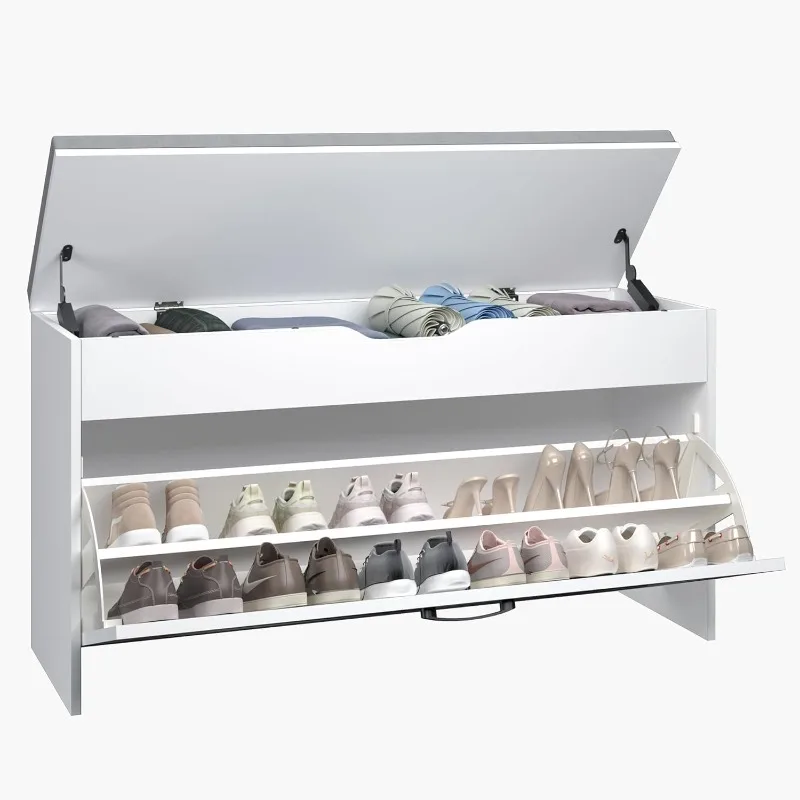
Creative Storage Solutions for Entryway Benches
Maximizing storage transforms a simple bench into a hardworking home organizer. Under-bench solutions include:
- Open shelving for frequently used shoes
- Baskets or bins for seasonal items
- Custom-sized drawer systems for smaller accessories
- Pull-out containers on wheels for ease of access
Built-in storage features worth considering when selecting an entryway bench include:
- Drawers for gloves, sunglasses, and other small items
- Lift-top seating that conceals larger seasonal gear
- Cubbies of various sizes for different household members
- Shelf systems for shoes of different heights
For small entryways, vertical thinking becomes essential. Wall-mounted hooks above your bench double its functionality, while entryway benches with drawers pack maximum organization into minimal floor space. Consider season-specific arrangements that can be adjusted as needs change throughout the year.
Styling Wooden Benches in Living Spaces
Living rooms and family spaces offer numerous opportunities for wooden bench placement that goes beyond conventional thinking. Consider placing your bench:
- Against an empty wall to create a reading nook
- Behind a sofa as a console alternative
- In front of a window to create a light-filled seating area
- Centered as a coffee table alternative
- In pairs to create flexible conversation zones
The styling approach should reflect both the bench’s function and the room’s aesthetic. For decorative accent pieces, create visual interest with:
- Artfully arranged coffee table books
- Small potted plants or botanical displays
- Decorative objects with varying heights and textures
- Trays that corral smaller items into an intentional grouping
For benches primarily used as seating, comfort becomes key. Layer cushions of different sizes, add throw blankets for texture and warmth, and consider how the bench positions users within the room’s flow of conversation.
Practical uses for dual-purpose benches enhance their value in living spaces. A bench that provides seating during gatherings might serve as a display surface for family photos or collections during quieter times. This adaptability makes wooden benches particularly valuable in homes where space must work hard to earn its keep.

Accessorizing Your Living Room Bench
The hard surfaces of wooden benches benefit from softening through thoughtful textile choices:
- Seat cushions in complementary colors add comfort and visual interest
- Throw pillows create back support when the bench serves as seating
- Table runners protect wood surfaces when used as display areas
- Textured throws draped casually add warmth and invitation
Decorative objects that enhance wooden benches include:
- Natural elements like driftwood or stone that echo the organic quality of wood
- Metallic accents that create pleasant contrast with wooden tones
- Ceramic pieces that add color while complementing the earthy nature of wood
- Glass items that create visual lightness against solid wood surfaces
Seasonal refreshes keep your bench styling current and interesting. Spring might call for lighter textiles and botanical elements, while winter arrangements might include heavier textures and warmer colors. This adaptability allows your wooden bench to remain relevant through changing seasons and design trends.
Wooden Benches in Dining Areas: Beyond Traditional Seating
Dining benches offer numerous advantages over conventional chairs in eating areas:
- Space efficiency (benches can tuck completely under tables when not in use)
- Flexible capacity (accommodating different numbers of people as needed)
- Visual cohesion (creating less visual clutter than multiple chairs)
- Enhanced intimacy (bringing diners closer together)
When incorporating a bench into your dining arrangement, consider these guidelines:
- Height compatibility: Ensure the bench height allows comfortable dining (typically 18-19 inches)
- Length proportion: The bench should cover approximately 80% of the table length
- Clearance needs: Allow 24-30 inches between the table edge and any opposing seating
Mixed seating arrangements—combining benches on one side with chairs on the other—create visual interest while offering different comfort options for diners. This approach works particularly well in rectangular dining settings where the bench can be placed against a wall to maximize space.
Warm farmhouse bench styles pair beautifully with rustic or traditional dining tables, creating an inviting atmosphere that encourages lingering conversations. For comfort during longer meals, consider cushioned options or add your own seat padding that can be removed for cleaning.
Creating Peaceful Retreats: Wooden Benches in Bedrooms
Bedroom bench placements create functional zones within your most personal space:
- End-of-bed positioning creates a spot for morning routines and nighttime preparation
- Window-adjacent placement establishes a private reading or reflection area
- Wall-aligned placement offers dressing support and clothing organization
- Corner placement creates a private moment within the larger room
Each location serves different functional and aesthetic purposes while adding architectural interest to the bedroom. End-of-bed benches typically measure 12-18 inches narrower than the bed width for balanced proportions.
Styling bedroom benches differs from public-space approaches:
- Emphasize softness and comfort with plush cushions and throws
- Select accessories that promote calm and restfulness
- Include practical elements like catch-all trays for jewelry or watches
- Consider intimately scaled lighting nearby for evening use
Storage capabilities become particularly valuable in bedroom settings, where containing clutter contributes to restfulness. Small entryway benches can double as bedroom seating while offering hidden storage for extra bedding, seasonal clothing, or personal items.
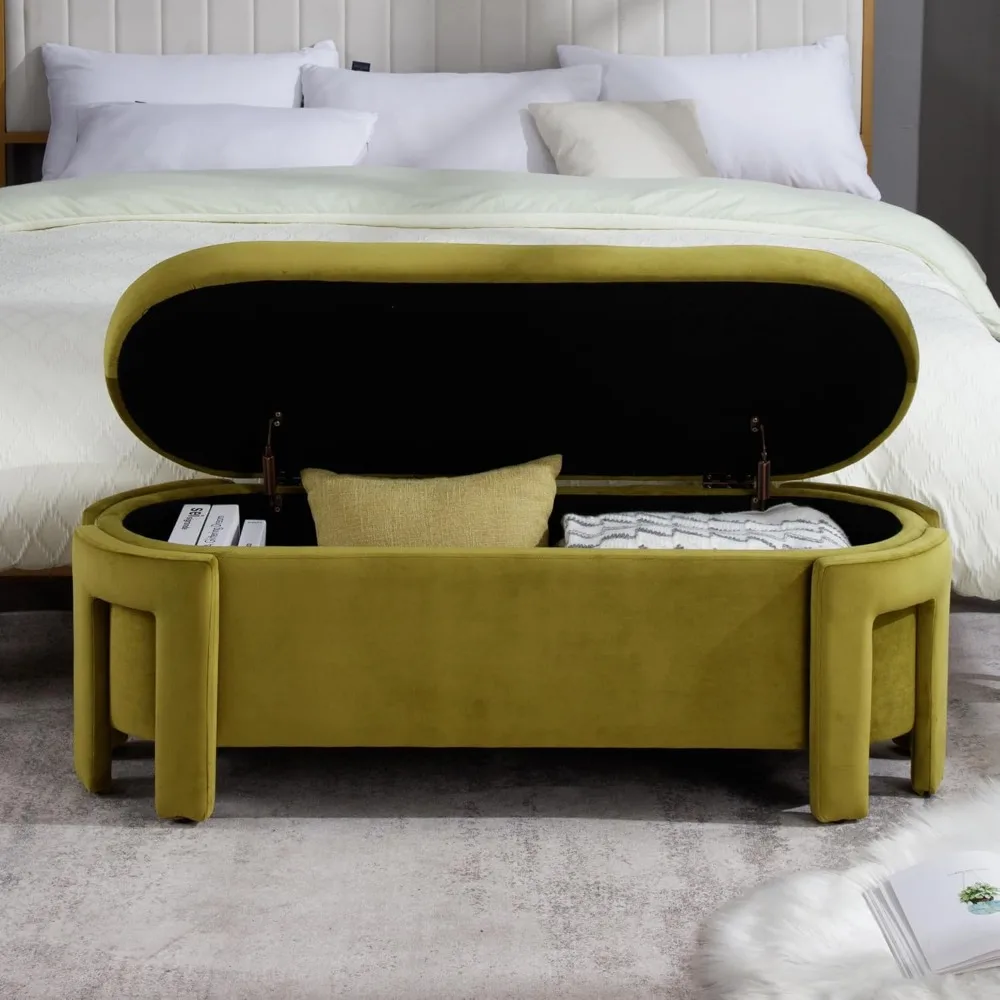
Unexpected Places: Creative Uses for Wooden Benches
Wooden benches shine in unexpected locations throughout the home:
- Hallways and corridors: Narrow benches create rest stops and display opportunities in transitional spaces
- Bathrooms: Water-resistant wooden benches provide seating and towel storage near showers or tubs
- Home offices: Benches offer secondary seating for collaborative moments or reading breaks
- Mudrooms: Sturdy benches create transition zones for removing outdoor gear
- Covered porches: Weather-appropriate benches extend living space to the outdoors
- Libraries or reading nooks: Window-adjacent benches create inviting spots to lose yourself in books
Each application demonstrates the remarkable adaptability of wooden benches across different functional needs and spatial constraints. Rustic hallway bench ideas transform often-overlooked corridors into featured design moments that add character and utility.
Weather-Resistant Options for Covered Outdoor Spaces
Semi-protected outdoor areas like covered patios and screened porches benefit from wooden benches that balance indoor refinement with outdoor durability. Wood types well-suited for these transition spaces include:
- Teak, with its natural oils that resist moisture
- Cedar, known for rot resistance and pleasant aroma
- Acacia, offering durability and affordability
- Shorea, providing teak-like qualities at a lower price point
Protective treatments become essential for long-term performance:
* Marine-grade varnishes create moisture barriers
* UV-inhibiting finishes prevent sun damage and fading
* Semi-annual reapplication of oils maintains weather resistance
Styling for covered outdoor benches should acknowledge the indoor-outdoor nature of these spaces. Choose accessories that bring indoor comfort but can withstand occasional exposure to elements—think weather-resistant fabrics, durable natural materials like jute or sisal, and easily movable decorative elements.
The Art of Styling: Universal Tips for Wooden Bench Decor
Regardless of where your wooden bench resides, certain styling principles ensure it looks intentional and beautiful:
- Layer textures to create visual and tactile interest (smooth wood with nubby fabrics, rough ceramics with polished metals)
- Use the rule of odds—groupings of 3 or 5 items generally look more artful than even numbers
- Create height variation among accessory items for dynamic visual flow
- Balance color distribution across the styled surface
- Include negative space to prevent a cluttered appearance
Color palettes that complement wooden tones depend on the specific wood:
* Light woods (maple, ash, pine): Blue-greens, soft blues, and coral tones enhance warmth
* Medium woods (cherry, oak): Deep blues, greens, and warm neutrals create harmony
* Dark woods (walnut, mahogany): Crisp whites, soft grays, and jewel tones provide striking contrast
Proportional considerations matter—a substantial bench calls for fewer, larger accessories, while a delicate bench benefits from smaller-scaled items. This balance prevents visual overwhelm while maintaining interest.
Working with Different Wood Tones in Your Decor
Mixing wood tones successfully requires understanding undertones:
* Red-based woods (cherry, mahogany)
* Yellow-based woods (pine, some oak)
* Brown-based woods (walnut)
* Gray-based woods (weathered or cerused finishes)
Woods with similar undertones naturally harmonize, while intentionally contrasting tones create dynamic interest. The key to successful mixing lies in purpose and repetition—when a wood tone appears more than once in a space, it reads as intentional rather than accidental.
Creating cohesion when working with diverse wood elements involves:
* Repeating each tone at least twice in the space
* Using textiles that incorporate multiple wood tones in their pattern or color
* Adding metal, stone, or glass elements that bridge between different woods
* Ensuring consistent finish levels (all matte or all glossy) even when colors differ
Multi-Functional Magic: Beyond Basic Seating
Wooden benches excel when asked to serve multiple functions:
- Coffee table alternative: A bench with the right height (16-18 inches) provides surface area while offering occasional seating
- Display platform: Showcase books, collectibles, or seasonal arrangements on a bench surface
- Plant stand: Elevate greenery at varying heights while introducing natural wood texture
- Room divider: Define separate functional areas within open floor plans
- Impromptu dining surface: Provide additional serving space during gatherings
These versatile applications demonstrate why wooden benches represent such smart investments—their ability to adapt to changing needs makes them valuable beyond any single function. Entryway benches with shelf storage exemplify this versatility, offering seating, display space, and organization in one thoughtful piece.
Entryway Bench with Shelf Storage, Shoe Bench for Entryway, Shoe Storage Bench
$194.08 Select options This product has multiple variants. The options may be chosen on the product pageModern Entryway Bench, Wood Entryway Bench, Wood Mudroom Bench
$497.69 Select options This product has multiple variants. The options may be chosen on the product pageEntryway Bench with Cushion, Small Entryway Bench
$466.79 Select options This product has multiple variants. The options may be chosen on the product pageEntryway Bench with Shelf Storage, Small Shoe Bench
$151.16 Select options This product has multiple variants. The options may be chosen on the product page- Price range: $785.40 through $897.63 Select options This product has multiple variants. The options may be chosen on the product page
Coat Rack Shoe Bench, Entryway Coat Rack Bench, Entryway Hall Tree, Wood Entryway Bench
$479.82 Select options This product has multiple variants. The options may be chosen on the product page
Care and Maintenance for Lasting Beauty
Preserving your wooden bench’s beauty requires regular but simple maintenance:
- Dust frequently with a soft, dry cloth to prevent particle buildup
- Clean spills immediately to prevent staining or water damage
- Apply appropriate wood cleaners quarterly (matching to your finish type)
- Use coasters and placemats to prevent water rings and heat damage
- Avoid direct sunlight exposure that can cause uneven fading
Addressing common issues keeps your bench looking its best:
* Minor scratches: Touch up with matching wood markers or crayons
* Water rings: Apply mayonnaise or a mixture of olive oil and salt, letting it sit overnight
* Loose joints: Reglue and clamp or consult a professional for structural repairs
* Dulled finish: Refresh with appropriate polish or conditioner specific to your wood type
Seasonal care makes a difference—winter heating can dry wood, requiring additional conditioning, while summer humidity might necessitate dehumidification to prevent swelling. This thoughtful attention ensures your wooden bench remains beautiful for years to come.
Sustainable Choices: Eco-Friendly Wooden Bench Options
Making environmentally conscious decisions about wooden furniture involves understanding several factors:
Reclaimed wood offers numerous benefits beyond unique character and visual interest. These pieces divert materials from landfills, reduce demand for new timber harvesting, and often contain old-growth wood with tight grain patterns no longer available in newly harvested lumber. Each piece tells a story through its patina and wear patterns.
For newly manufactured benches, look for certifications that verify sustainable forestry practices:
* Forest Stewardship Council (FSC) certification ensures responsible forest management
* Sustainable Forestry Initiative (SFI) verifies compliance with environmental standards
* Programme for the Endorsement of Forest Certification (PEFC) confirms sustainable sourcing
Beyond material sourcing, consider production methods and finishes. Water-based finishes emit fewer volatile organic compounds than traditional oil-based alternatives, while companies using solar power or other renewable energy sources reduce the carbon footprint of manufacturing processes.
Perhaps the most sustainable choice is investing in quality construction that ensures longevity—a well-made bench that lasts for decades represents a far smaller environmental impact than multiple disposable pieces over the same timeframe.
Finding Inspiration: Curated Wooden Bench Styling Ideas
Transform your wooden bench with these inspired styling approaches:
- Monochromatic magic: Choose accessories in varying shades of a single color family to create sophisticated, cohesive arrangements
- Botanical focus: Incorporate plants of different scales—from small succulents to larger trailing specimens—to bring life and movement
- Textural contrast: Pair smooth ceramics with rough-hewn wood elements, soft textiles, and perhaps something unexpectedly sleek like glass
- Functional groupings: Arrange everyday items (books, remote controls, coasters) in visually pleasing ways using trays and containers
- Seasonal statements: Rotate decor elements to reflect changing seasons, from spring blossoms to autumn gourds to winter evergreens
The most successful styling reflects your personal aesthetic while respecting the inherent beauty of the wooden bench itself. Remember that sometimes less is more—allowing the wood’s natural grain pattern and color to remain visible preserves the bench’s fundamental appeal.
Whether your style leans traditional, contemporary, or somewhere in between, wooden benches offer endless possibilities for enhancing your home’s beauty and functionality. Their timeless appeal ensures they’ll remain relevant through changing trends, making them one of the wisest furniture investments you can make.

